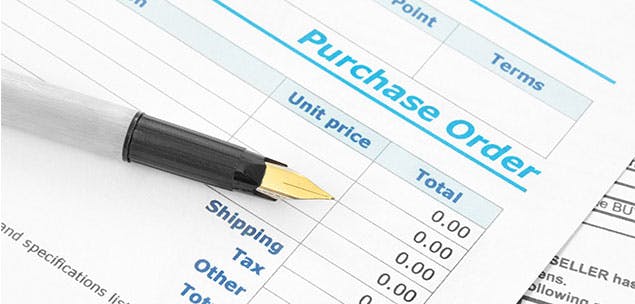It is rarely a good idea for any business to stand still and resist change as they could then find themselves at a disadvantage compared to their rivals, which is why it makes sense to see how automation can simplify yet improve your business processes at the same time.
Here is an overview of the various types and components of a typical purchase order system and a look at how you can gain a greater level of visibility and control over your purchases.
Understanding purchase orders
A good starting point would be to take a moment to define exactly what a purchase order is and what part it plays in the general running of your business.
In basic terms, a purchase order is created when the purchaser sends an order to a specified vendor for the goods or services that they want. The order will need to cover some standard information such as the quantity of each item required along with other variable terms that need to be clarified, like the agreed price per unit and standard delivery and payment terms.
All of this might seem straightforward but collating all this information for each purchase order takes time and can be a drain on your administrative resources.
This is why it can help to streamline your business and try to automate the process by identifying the different types of purchase orders and then use the opportunity of software solutions to create a more automated purchase order management system.
Breaking down your purchase order needs
To be able to create an IT system that works for your business your first task will be to look at the main types of purchase orders and see how each one has a place in your daily trading functions.
A standard purchase order will often be used for what could be classed as irregular or one-time procurement needs. This can be created fairly easily as the data requirements often stay the same, such as price, quantity etc.
You might also have a need to create planned purchase orders, which is a more comprehensive document that often follows a sequence of orders to fulfill an order over a period of time.
Blanket purchase orders are useful for ordering goods and services across a range of different suppliers, and contract purchase orders would be used if you have an ongoing relationship with a number of specific suppliers.
The case for a purchase order management system
If you are looking for an idea on what automation has to offer in this aspect of your business administration you can see what DataServ has here for an example of certain features.
Many businesses can often have a need to process routine purchases in large volumes. Therefore, it makes sense to try and develop an IT system that helps you to track and manage those purchases far more efficiently than and expediently than you could with just a manual system in place.
Processing purchase orders are both a tedious and laborious task in equal measure. Investing in an integrated system removes that labor-intensive scenario and should make your business run a lot more smoothly.
What to look for in a purchase order management system
The system will ultimately only be as robust and efficient as you want it to be if you take the time to work out exactly what you need and create a framework that covers all the purchasing requirements of your particular business.
Some of the major advantages that automated systems offer are available with plenty of packaged purchase management systems as well as bespoke designs. You will often want to be able to create purchase orders automatically by auto-filling the relevant purchase order fields with standard details for such as billing and shipping address, applicable tax rate and other similar data.
A good way of getting the most of your system would be to set some parameters that allow you to make purchasing as seamless as possible with an automated approval process.
Another useful function to consider would be the ability to set up a communication protocol where you are able to generate automated email notifications for each purchase order generated.
Any purchase order management system can only be as good as the input and thought that you put into creating a system that works for your business.
An automated purchase order system should enhance the efficiency of your business and allow you to concentrate on growing the company when you don’t have to worry so much about manual administrative tasks.
About the author
George Owens has worked as a procurement manager for several years. He enjoys sharing his knowledge, whether discussing walk or his personal life and does this through his writings online.

